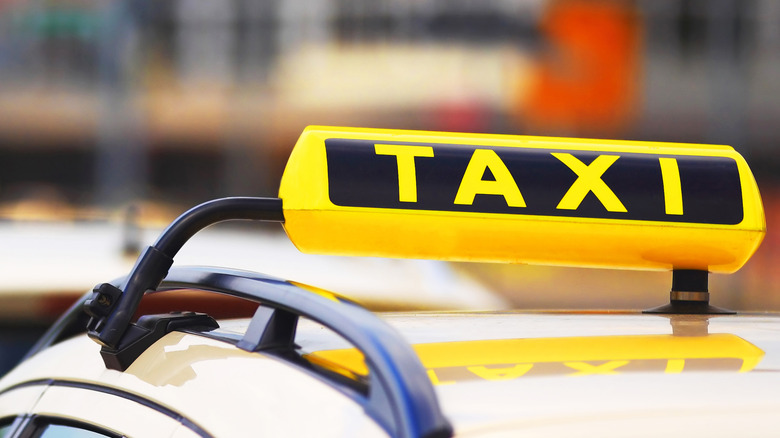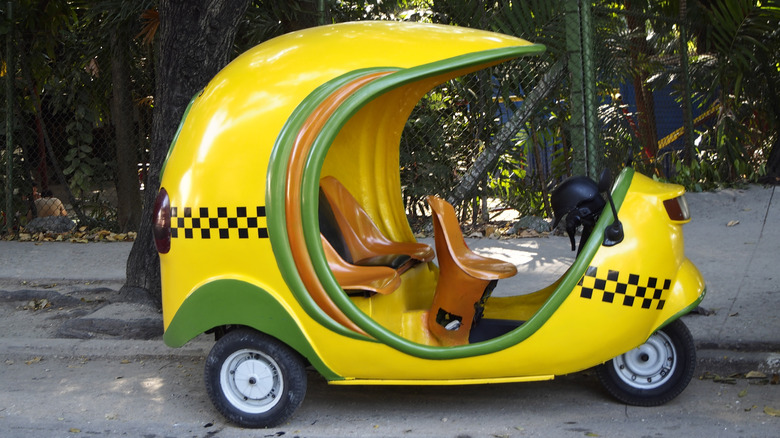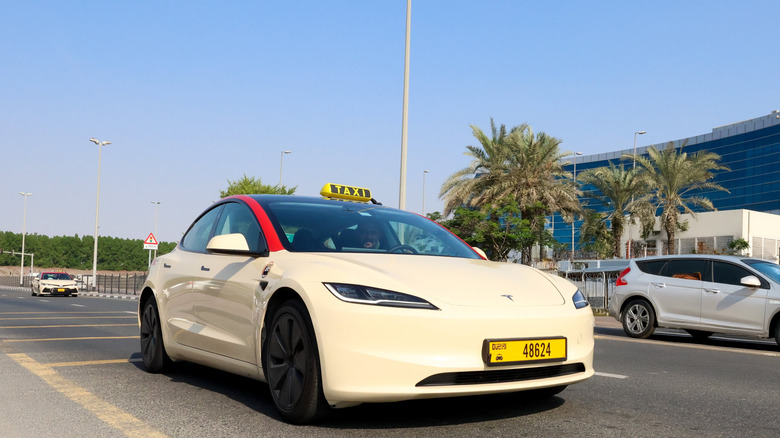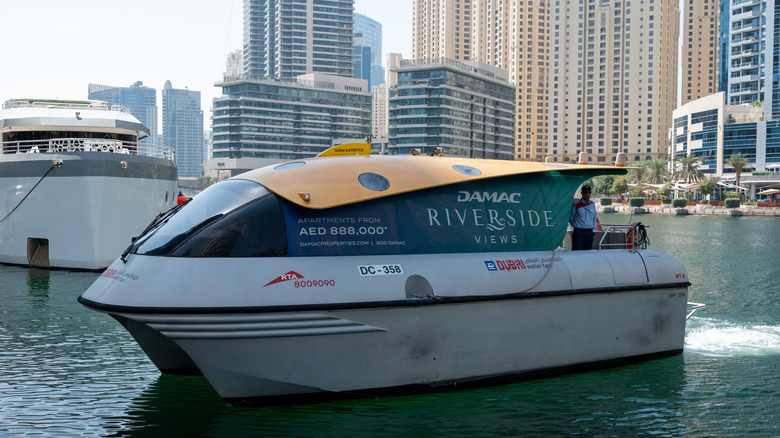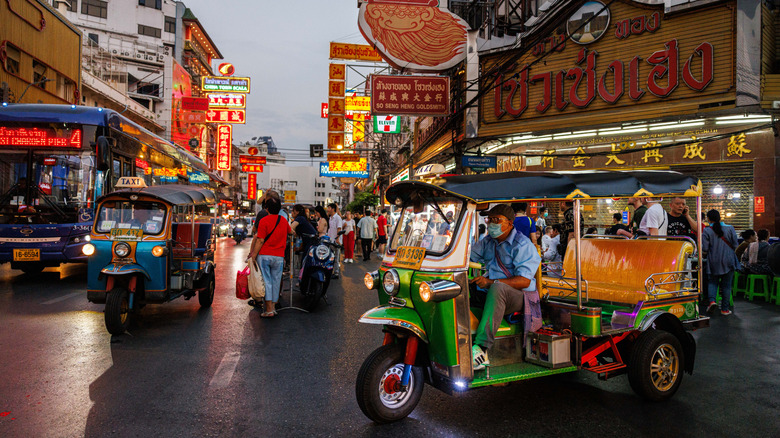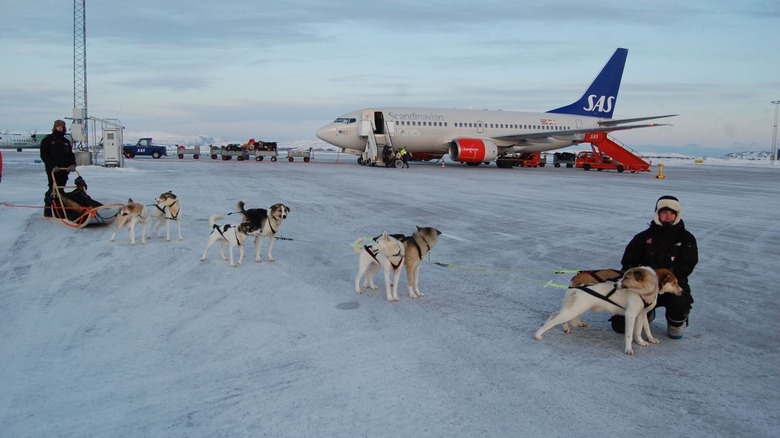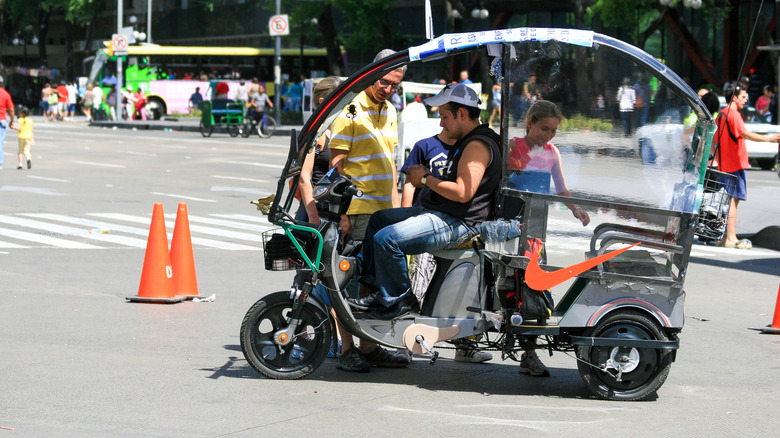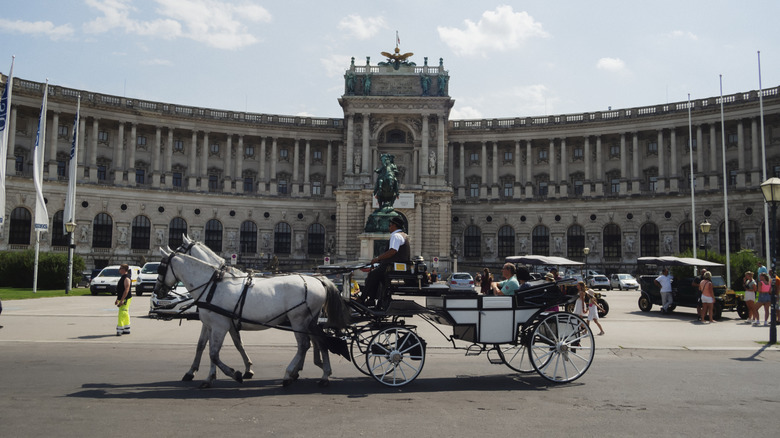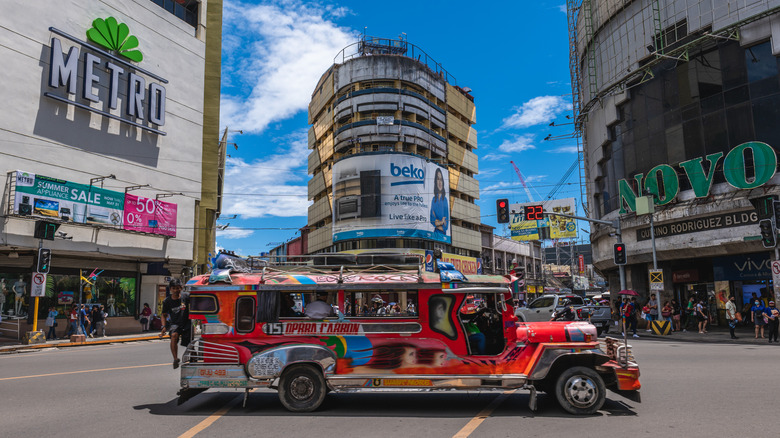10 Of The Weirdest Taxis Still Used For Public Transport
Taxis have long been a convenient way to get from point A to B when you don't have — or don't want — a car of your own. Tourists use them, locals use them, and students practically live by them. In fact, the first recorded taxi service was in the 17th century, where innkeepers would hire out horse-drawn carriages to their guests. And while a horse-drawn carriage today might be considered more of an oddity than the norm, several other types of taxis still in operation would certainly raise eyebrows too.
If you thought choosing an NYC yellow cab instead of an Uber was about as exciting as taxis can get, buckle up, because the world of taxis is far stranger than you ever imagined. And it goes beyond modern luxuries — somewhere along the way, things took a very strange turn. Not every city settled for a simple sedan with a dome light.
For this list, we're not looking at gimmicks or novelty rides that someone cobbled together for a YouTube thumbnail. These are all real, working taxis — so we won't be including stuff like the Soviet-era VNIITE-PT taxi — and they're are about as far from the average Prius as you can get. We'll take you through tuk-tuks that dart through Bangkok like caffeinated wasps, water taxis that can outpace street traffic by running on the river, and even bright pink rides designed to make a statement.
Coco-Taxis in Cuba
Step out of the airport in the Caribbean nation of Cuba and you'll undoubtedly see one of its many "Coco Taxis" zooming about the bustling roads. They're called Coco-Taxis because their egg-shape is apparently supposed to resemble half a coconut, but that is probably more a matter of opinion than fact. Coco Taxis are always painted a bright lemony yellow, and are similar to rickshaw taxis (more on those later). Although nearly every Coco Taxi is the same size, shape and color, each one is individually owned by its driver, rather than a centralized company.
The fares on Coco Taxis are supposedly lower than regular cabs, but because there is no centralization — or even a meter system — the owners of the taxis can set their own rates. The bodies of all Coco Taxis look the same, made out of fiberglass with a scooter as the base "frame," for want of a better word. It's kind of like a really big, permanent umbrella attached to the scooter. So, you'll have your driver in front, and behind him (inside the shell) you'll have two or three seats where passengers can sit. Supposedly, the yellow taxis are for tourists, and there are black ones only for locals, but the latter are rarely seen, if at all. They are quite a funky way to get around most major Cuban destinations, and will undoubtedly make for great vacation photos — a true must try.
Teslas in Dubai
In most parts of the world, a Tesla is a status purchase, but in the land of oil money, they're plain old taxis. The inclusion of Tesla EVs in the taxi fleet of Dubai, United Arab Emirates, is a somewhat recent development. The Road and Transport Authority (RTA) in Dubai only announced it would trial Tesla Model 3s as taxis in 2022. However, clearly the trial run was successful, because in 2023 the Dubai Taxi Corporation (DTC) added 269 Teslas to its operational fleet after approval from the RTA. All of these moves are part of the UAE's greater plan to have a 100 percent electric fleet by 2027. Oh, and seeing how Dubai is the land of excess, the Dubai Taxi Corporation also has a fancy new Tesla Cybertruck as a taxi — it might even introduce air taxis in the future, too.
After the success of Tesla taxis in Dubai, the neighboring emirates of Abu Dhabi and Sharjah also added several units of the Tesla model S and Model 3 to their respective taxi fleets. Today, the EV taxi market in the UAE is quite mature, with other brands beginning to play in the space. Only recently, the DTC announced an order of 200 SEALs from Tesla rival BYD to meet their fleet targets by 2027. So, while the rest of the world squabbles over EV legislation, a petro-state is leading the charge for EV adoption, though admittedly, having them as taxis is an odd way to do it.
Rickshaws in Kolkata, India
In Kolkata, India — formerly known as Calcutta — about 3,500 hand-drawn rickshaws are still in operation, ferrying passengers from place to place. Invented in 19th-century Japan, the word rickshaw is an anglicization of the Japanese word "jin-riki-sha," which literally translates to "human powered vehicle." From Japan, the rickshaw came to India thanks to the British, who introduced the Hackney Carriage Act in 1919, which legalized the rickshaw in India. Many governments around the world want to phase these hand-drawn carriages out, but they still persist due to cultural requirements, and a lack of alternative careers for the operators. For one, many of the rickshaw-pullers are migrant labor, who come in from neighboring states in the farming off-season, when they can't make ends meet.
Two, though the government does not issue new rickshaw licenses, and doesn't renew old expired ones now, they have not provided any sort of rehabilitation for the operators. One benefit that the rickshaw taxis have is that they have no emissions, and can go where other vehicles simply cannot, such as through Calcutta's haphazard, unplanned gullies (streets) and minor roads. What once was a symbol of colonialism is now so deeply integrated into the very fabric that makes up Calcutta, that it is seemingly impossible to phase out. However, they still are a quaint way to get about a quaint city, and in doing so, you'll be helping at least one person make ends meet for the day.
Water Taxis in Venice and Dubai
Many places close to the coast or with well-developed waterways are now opening up to the idea of using water taxis to ferry passengers about. Venice, of course, has been doing it for years — the city has no paved roads, only a labyrinth of canals. As such, every taxi in Venice can be called a water taxi.
However, cities like Dubai have also introduced water taxis to pick you up from one marina and let you off at fixed drop-off points. You can book your seat using a centralized app or website, though if you want a round trip ticket you'll have to visit a ticketing counter at one of the departure points. Alternatively, you could also book a one-day pass for select routes starting at about $7 (25 United Arab Emirates Dirham).
The Dubai water taxis are purpose-built by Dutch shipbuilding house Damen, fully made of a composite material and powered by Rolls-Royce waterjet engines. They can seat 10 people at maximum, are fully air conditioned, and mostly run around the Bluewaters, Dubai Canal, and Dubai Marina areas. A key reason why people hate Ubers so much is the traffic, which the water taxis avoid — all while taking in views of the skyline while relaxing in a leather seat with a personal LCD screen that reclines to 45 degrees as your cruise along at 34 knots.
Tuk tuks in Thailand
Our next vehicle is most prevalent today in Sri Lanka, India, and Thailand, though arguably Thailand has made them famous. Known as "Sam-Lor" in the local language, which literally means "three wheels," they are open at the side, and can comfortably seat three people. Though in both Bangkok and India you'll see them with five people (two sitting on either side of the driver in front) — truly an experience. Tuk tuks came to Thailand from Japan, and were initially just motorized versions of cycle-rickshaws. Many people tend to assume tuk-tuks are only for tourists and foreigners, but they are super important for Thai locals as a means of transport as well.
You may also be surprised to learn that there is more than one kind of tuk tuk — "tuk tuk" is actually a class of vehicle, rather than the vehicle itself. In Bangkok city, you'll rarely see anything other than the standard yellow-and-black tuk tuk taxi that operates on a "for hire" basis. However, the farther you go from Bangkok, the more variation you will see, including six-seater versions, pickup versions, green and black ones, and many more. Some don't even operate for hire, and instead just shuttle people along fixed routes, mostly along very long roads. They are a sight to behold, and no visit to Thailand is complete without riding in one.
Snowmobile Taxis in Sweden
In a country as cold as Sweden, it snows a lot. So it should be no surprise then, that you can find snow-specific vehicles operating as taxis in the region. For example, most famously in the snow-logged regions of Abisko and neighboring Kungsleden, you and your gear can travel in sleds pulled by snowmobiles! Snowmobile taxis can accommodate a party of up to four, and the operators will provide you with warm clothing and blankets if you so desire. The main routes are from Abisko to Abiskojaure, Alesjaure, Unna Alakas, and Tjäktja. Now, one could argue that these are more novelty sightseeing than taxi, but the fact remains that it is a regular, scheduled service between these arctic regions, and you can book your spot — in our books, that's a taxi.
Prices for this once-in-a-lifetime experience start from about $58 (560 Swedish Krona) to about $154 (1,490 Swedish Krona). What's nice is that the cost of transporting your gear (skis, helmets, boots, backpacks, etc.) is included in these prices, and there's plenty of room in the sled to stow them away safely. And if you want a more curated experience, there is a separate service called Görans Fjälltransport, which is basically a snowmobile to Kebnekaise mountain station for sightseers.
Husky Taxis in Norway
Some parts of the world are living in 2090, considering selling flying cars to the public. Norway, however, is keeping taxis refreshingly simple — with a sled pulled by a pack of husky dogs. This is originally what huskies were bred for, operating in snow-clad areas, where their special fur keeps them insulated from the cold. There are also horse-drawn variations of these sleds, but either version will whisk you right from Kirkenes airport to the city.
You have to reach out in advance, give the operating team your party size, number of bags, and flight arrival details, and they'll handle the rest. Once you land, your husky team will meet you at the airport, accompanied by a professional dog handler (the guy who yells out "mush, mush"), called a "musher." You'll be given an overall, balaclava, mittens, and warm boots by the musher, and then be on your way.
Currently, one sled is shared between two passengers, but accommodations can be made for as many people as required — by adding more huskies of course. And if you're worried about your luggage, that'll be secure and waiting for you at the hotel where you're going, having been sent ahead by car or van. So, while you enjoy the views of the snow-clad landscape and fjords, you won't have to worry about your bags falling off the sled.
Note: Many people use it, but this is more of a sightseeing tour, and only available for those leaving the airport, not heading for it.
Bicitaxis in Mexico
A bicitaxi is exactly what it sounds like: a bicycle taxi that can comfortably seat two people at the back, with one driver in front — or would we call them riders? These Bicitaxis can be found all around Mexico, where the locals call them "Ciclotaxis" and are painted a distinctive bright green color. In 2009, the Mexican government released a directive called the "Green Plan," and these bicitaxis were introduced as a key part of that plan. Each bicitaxi driver has also been made to take a basic history lesson, which means that effectively, each one is also a tour guide for you. Not a bad package overall, considering that rides start from just about $1 (20 pesos).
If you've been to Mexico before, you'll know that a preliminary version of the bicitaxi was the Mexican pedicab, but the main difference here is that the bicitaxis have a motor that is powered by a battery. Bicitaxis are a great way to explore many parts of Mexico, and you'll also beat the (mostly) horrible traffic, as a bonus — all while contributing to the local economy without emitting any pollution. It's a win-win-win situation, and certainly one of the strangest taxis you'll ever see.
Horse-drawn carriages in Vienna
Popular among young couples and romantics, horse-drawn extremely embellished and adorned carriages can ferry you around Vienna — more exciting than even your oddest uber rides. Locally known as a "fiaker," each carriage is pulled by two horses at minimum. The name is of French origin, derived from what the Hackney carriage stands of Paris used to be called. Somewhere along the way, the Vienna horse carriages that were earlier called "janschky" were renamed to fiaker, and also given numbers to identify them. From the mid 1800s to 1900, fiaker drivers were mostly well-known artists (such as singers), who had a following in the city. Today, fiakers live on in many parts of Vienna, with major stands in Stephansplatz, Volksgarten, and Michaelerplatz, to name a few.
The two main rides that fiaker taxis offer cost around $118 (105 euros) and $68 (60 euros), for the long and short tours respectively. The shorter ride lasts 20 minutes and takes you through the charming old city area, and the longer 40 minute ride takes you through the old city as well as the Ringstrasse section. And of course, you can also charter or hire a Fiaker to take you pretty much wherever you want. It's truly an old money way of traveling, even if it is less efficient than a car.
Jeepneys in Manila
A fixture of Philippine transportation, the "jeepney" originated in the post-WWII era, when people started modifying jeeps the U.S. military left behind. The aim was to use these elongated open-air jeeps as taxis, and in time, they were produced in the Philippines from scratch. Jeepneys are distinctly bright-colored, and often adorned with mirrors, art, and other knick-knacks.
Currently 185,000 jeepneys amble along Philippine roads, but they're being phased out, as most are quite old and pollute the environment a lot. The University of the Philippines estimates that jeepneys account for more than 50% of all particulate airborne pollution in Manila proper, or metro Manila. To combat this, the Philippine government is forcing many Jeepney drivers to gradually convert to greener vehicles. However, the flood of used jeepneys on the market that this has caused has made their value plummet. Given that a government-approved replacement bus can cost as much as about $50,000 (2.8 million pesos), the move could put many drivers out of business, altogether.
It'll be sad to see the Jeepneys go, as they were true cultural icons of the country — a sci-fi mix between car, jeep, and minibus, all rolled into one and painted the brightest color you could find.
